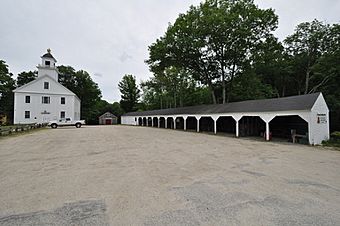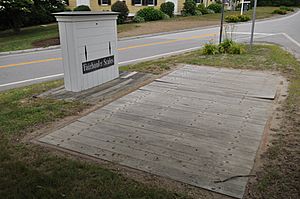Francestown Town Hall and Academy and Town Common Historic District facts for kids
Quick facts for kids |
|
|
Francestown Town Hall and Academy and Town Common Historic District
|
|

The town hall/academy and horse sheds
|
|
| Location | Jct Greenfield Rd. and New Boston Rd., Francestown, New Hampshire |
|---|---|
| Area | 1.6 acres (0.65 ha) |
| Built | 1772 |
| Architectural style | Greek Revival |
| NRHP reference No. | 16000143 |
| Added to NRHP | April 5, 2016 |
The Francestown Town Hall and Academy and Town Common Historic District is a special area in Francestown, New Hampshire. It has many old buildings and spaces from the 1700s and 1800s. These places were important for the town's government and community life.
This historic district includes the town hall, an old school building, and the town common. The town common is a public park area. You can find a rare old weighing scale there. This whole area was added to the National Register of Historic Places in 2016. This means it's recognized as an important historical site in the United States.
History of Francestown
The town of Francestown started in the late 1740s. It officially became a town in 1772. That same year, a person named John Fisher gave the town about 4 acres of land. This land was meant to be a town common and a center for the community.
The northern part of this land was used for the town cemetery. It also held the town's first meetinghouse. A meetinghouse was a building used for both town meetings and religious services.
The Town Hall and Academy
The southern part of the land stayed open until 1846. That's when the town hall and academy building was constructed. This building has been used for many different things over the years.
It served as the town hall, where local government decisions were made. It was also a school for many years. Sometimes, both the town hall and school functions happened at the same time! The building even housed the post office. Even with all these changes, it still has many of its original features.
Right next to the town hall is another building called "The Beehive." This building was a dormitory for students. A dormitory is a place where students live while they are studying at a school or academy.
The Town Common and Scale
The open area of the common is between the old meetinghouse and the town hall. Some parts of it have changed because of road widening projects. A small triangle-shaped section is now separate from the main common area.
On this smaller section, you can see a granite watering trough. This was put there in 1889. There are also parts of a public platform scale. This scale was installed in 1908.
The working parts of the scale came from the Fairbanks Company. The town worked with a local hotel owner to install it. This hotel owner might have also sold hay, which would have been weighed on the scale. The town bought the scale completely in 1923.
Images for kids





